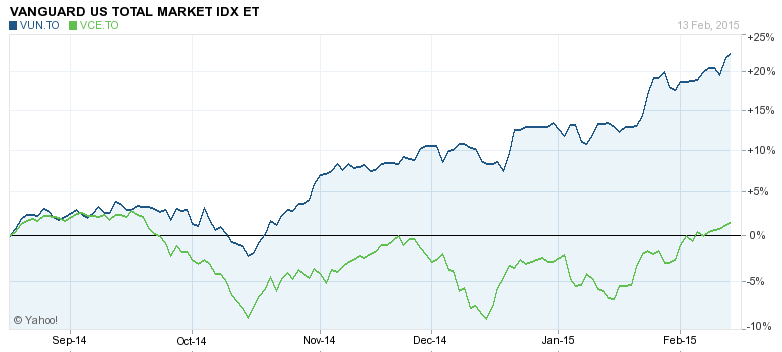In July, 2014, Vanguard Canada published a report titled Global equities: Balancing home bias and diversification – A Canadian investor’s perspective. Using data from the IMF, Vanguard showed that Canadians on average allocate almost 60% of their equity holdings to Canadian stocks, a significant overweight considering that Canadian stocks represent less than 4% of the global stock market.
At times, of course, the bias in the Canadian stock market towards banks and natural resource companies has been a return booster, not a detractor. Furthermore, the Canadian dollar has been strong at these same times.
Recently, however, the downside of not diversifying has become more apparent. It is interesting to look at the performance of two of Vanguard’s ETF’s, VUN.TO (Vanguard’s US Total Market Index ETF) and VCE.TO (Vanguard’s FTSE Canada Index ETF) over the last 6 months (since the Vanguard report was published).

While the Canadian market ETF (VCE) is barely treading water over the period the US market ETF (VUN) is up over 20% in Canadian dollar terms.
The risk of non-diversification is that it opens up an investor’s portfolio to investment specific risks that could otherwise be mitigated in a well-diversified portfolio. And for Canadian investors the last 6 months have been a perfect storm with downward pressure on the Canadian dollar and natural resource sectors, not to mention that the Canadian banks also have exposure to these sectors in their loan and mortgage books.
While some home bias is natural, diversification outside of Canada provides opportunities to increase investment returns while lowering risk. Please see Chalten’s evidence based approach for more rationale for diversification. The challenge is how best to do so. Canadian domiciled international equity funds have not exactly covered themselves in glory. Tim Shufelt pointed out in his November Globe & Mail article, Actively managed funds vs the index: once again, no contest, that only 1 in 70 Canadian domiciled US equity managers outperformed the S&P500 Total Return Index over the last three years. The evidence quite convincingly shows that investors are better served by using a low cost buy and hold strategy rather than by paying a manager to pick stocks or time the market, another core principle of Chalten’s evidence-based approach.
Canadians do need to diversify more outside their home market, and it’s best done with passive ETF’s or low cost mutual funds that provide intelligent market access.

